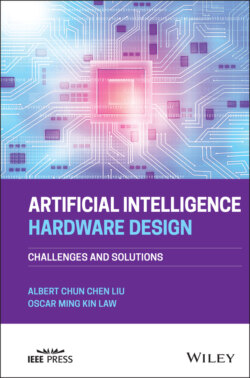Читать книгу Artificial Intelligence Hardware Design - Albert Chun-Chen Liu - Страница 11
Оглавление
Preface
With the breakthrough of the Convolutional Neural Network (CNN) for image classification in 2012, Deep Learning (DL) has successfully solved many complex problems and widely used in our everyday life, automotive, finance, retail, and healthcare. In 2016, Artificial Intelligence (AI) exceeded human intelligence that Google AlphaGo won the GO world championship through Reinforcement Learning (RL). AI revolution gradually changes our world, like a personal computer (1977), Internet (1994), and smartphone (2007). However, most of the efforts focus on software development rather than hardware challenges:
Big input data
Deep neural network
Massive parallel processing
Reconfigurable network
Memory bottleneck
Intensive computation
Network pruning
Data sparsity
This book shows how to resolve the hardware problems through various design ranging from CPU, GPU, TPU to NPU. Novel hardware can be evolved from those designs for further performance and power improvement:
Parallel architecture
Streaming Graph Theory
Convolution optimization
In‐memory computation
Near‐memory architecture
Network sparsity
3D neural processing
Organization of the Book
Chapter 1 introduces neural network and discusses neural network development history.
Chapter 2 reviews Convolutional Neural Network (CNN) model and describes each layer functions and examples.
Chapter 3 lists out several parallel architectures, Intel CPU, Nvidia GPU, Google TPU, and Microsoft NPU. It emphasizes hardware/software integration for performance improvement. Nvidia Deep Learning Accelerator (NVDLA) open‐source project is chosen for FPGA hardware implementation.
Chapter 4 introduces a streaming graph for massive parallel computation through Blaize GSP and Graphcore IPU. They apply the Depth First Search (DFS) for task allocation and Bulk Synchronous Parallel Model (BSP) for parallel operations.
Chapter 5 shows how to optimize convolution with the University of California, Los Angeles (UCLA) Deep Convolutional Neural Network (DCNN) accelerator filter decomposition and Massachusetts Institute of Technology (MIT) Eyeriss accelerator Row Stationary dataflow.
Chapter 6 illustrates in‐memory computation through Georgia Institute of Technologies Neurocube and Stanford Tetris accelerator using Hybrid Memory Cube (HMC) as well as University of Bologna Neurostream accelerator using Smart Memory Cubes (SMC).
Chapter 7 highlights near‐memory architecture through the Institute of Computing Technology (ICT), Chinese Academy of Science, DaDianNao supercomputer and University of Toronto Cnvlutin accelerator. It also shows Cnvlutin how to avoid ineffectual zero operations.
Chapter 8 chooses Stanford Energy Efficient Inference Engine, Institute of Computing Technology (ICT), Chinese Academy of Science Cambricon‐X, Massachusetts Institute of Technology (MIT) SCNN processor and Microsoft SeerNet accelerator to handle network sparsity.
Chapter 9 introduces an innovative 3D neural processing with a network bridge to overcome power and thermal challenges. It also solves the memory bottleneck and handles the large neural network processing.
In English edition, several chapters are rewritten with more detailed descriptions. New deep learning hardware architectures are also included. Exercises challenge the reader to solve the problems beyond the scope of this book. The instructional slides are available upon request.
We shall continue to explore different deep learning hardware architectures (i.e. Reinforcement Learning) and work on a in‐memory computing architecture with new high‐speed arithmetic approach. Compared with the Google Brain floating‐point (BFP16) format, the new approach offers a wider dynamic range, higher performance, and less power dissipation. It will be included in a future revision.
Albert Chun Chen Liu
Oscar Ming Kin Law
